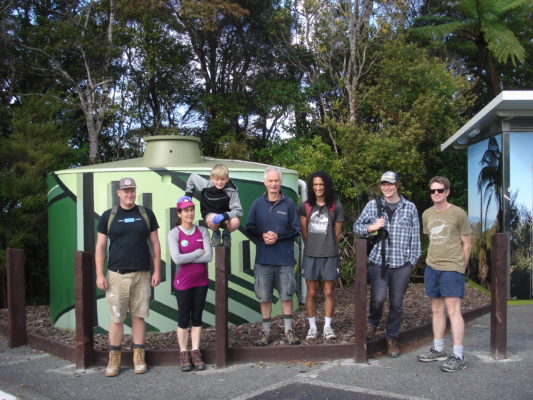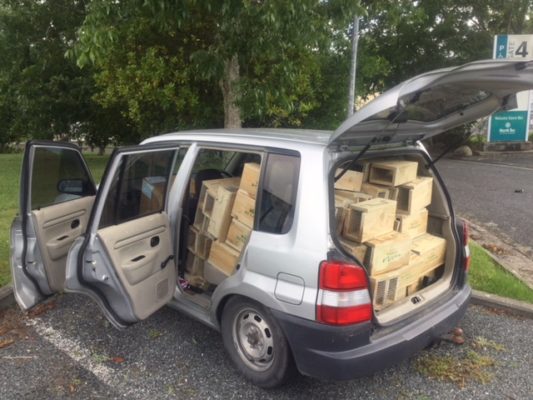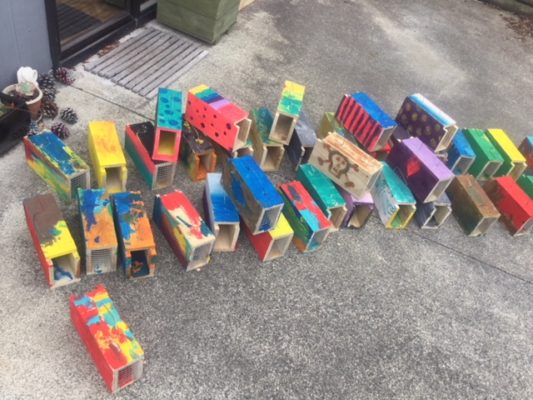Dai Morgan says there’s a job for everyone in the Parihaka Landcare Group.
“It’s not too onerous. There are different grades of work. It’s usually one Sunday a month and all done in three hours. The traplines can be checked in small sections,” he adds. “If we get enough people, we can do it very quickly. There’s not too much time on the job!”

Dai lives on the side of the hill at Parihaka, in Whangarei, and, back in 2016, was keen to do something to help the local wildlife, especially during the breeding season when most bird predation deaths occur.
“There’s 400 hectares of bush right next door,” he explains. “I’ve been involved in a few conservation organisations in recent years (Bream Head Conservation Trust, Kiwi Coast) but I really wanted to do something for my local bush. I started with a circular drop to other neighbours living adjacent to the bush – about 15 to 20 people initially responded.”
Dai reckons over 50 people have volunteered in the Parihaka Landcare Group so far, with about 15-20 people turning up each month – composed of a core group of about 15 and a variety of others who come when they can.
Initially Dai and his neighbours took on only 40 hectares of Parihaka (which is made up of several land parcels totalling about 400 ha) and focused their initial efforts on the bird breeding season.
Dai explains. “In the next year, the Whangarei District Council had some money left in its budget and we received support from the Kiwi Coast and the Mazda Foundation for additional traps, so we expanded into the next gully – another 30 hectares. This year we’ve added another 20 hectares, so that’s 90 hectares in total.”
Bait stations are spaced at 50 metre x 100 metre intervals across the 70 hectares (last year’s managed area), with about 220 bait stations in total. There are about 110 rat traps set at 100m x 100m spacing and around 50 possum traps spaced at 100m x 200m.
“Pest monitoring has shown there are way less rats and possums in the managed area,” Dai says. “The 3 tracking tunnel lines in the managed area are tracking at about 3% in the managed area compared with about 45% for the 3 tracking tunnel lines in the non-managed area. There has been some increase in birds too, but 5-minute bird counts aren’t the most robust form of monitoring,” he cautions, “and the increase in birds isn’t proven numerically.”
Dai has used Facebook and ‘Volunteering Northland’ to help get volunteers for the Parihaka project – but he also has a labour source not necessarily available to all conservation groups.

“I am a tutor on the environmental management programme at NorthTec,” he explains. “The students learn about pest monitoring and applied pest management – traps etc – with volunteer hours tying in with their course work.”
With the project right on their doorstep – on Dai’s doorstep quite literally – there’s no need to take classes long distance to participate in conservation.
“It’s a nice tie-in,” says Dai. “And 3 or 4 of the students have gone on to become regulars in volunteer groups at the weekends which is nice. I really like urban ecology,” he adds. “After all, 80% of us live in towns and this is where we get most of ecological experiences. Many people think urban areas are of low conservation value, but there is a lot of habitat within cities and towns that can support viable wildlife populations.
Dai says that the group has been “really lucky” with funding, and the group has had considerable support from a variety of organisations.
“The Whangarei District Council initially paid for our bait stations, bait and traps with help from a Northland Regional Council start-up grant. The Department of Conservation helped with possum traps, the Mazda Foundation helped with rat traps and the Kiwi Coast helped with stoat traps. Then last year we received a new community grant from the Whangarei District Council and a Northland Regional Council Biofund grant.”

A key reason for the funding success, Dai believes, is that the group is recognised as being ‘good value’.
“We’re giving a lot of in-kind support. A few thousand dollars in consumables goes a long way on the hill as all the labour is provided by volunteers. People feel really engaged and they feel they’re making a difference.”
There are benefits for the volunteers themselves too.
“There’s a lot of research that shows that personal wellbeing benefits from environmental volunteering,” Dai says. “People feel that they’re doing something of value, they get exercise and they meet others who are all volunteering for the same reason.”
Volunteering is a great way to get to know your neighbours and build a sense of community – as Dai knows from his own experience with Parihaka Community Landcare.
“I have been living back in Whangarei for about 5 years now and for the first two years, I only knew my neighbours. Now I know lots of people,” he says. “It’s really nice meeting people when I take the dog for a walk around the neighbourhood.”
All ages are involved in the Parihaka group, from a few school age volunteers, some tertiary students in their early 20s to a number of retired people.
“In another Northland Regional Council project I know of, they’re aiming to get more older people involved,” says Dai. “Older people have the experience and time, they have toolsheds with awesome tools and they have heaps of experience to pass on!”
As Parihaka Community Landcare has become more established, they’ve moved from seasonal to year-round predator control, and established a small organising committee to spread the workload.
“In the beginning you start with the low-hanging fruit,” Dai explains. “Before we did very intense predator control from August to November. But now it’s year-round – not just the breeding season, so it’s not just benefitting the birds now, but other wildlife as well.”
A spin-off group is also forming on the other side of the hill.
“A new group is starting down the north end,” says Dai. “Some guys that were helping out on the north end are now trapping close to where they live. They’ve carved off an additional 10 hectares of Parihaka and we hope to have our projects eventually join up. As more groups start carving off areas, those areas will eventually meet up and we’ll achieve big things!”

